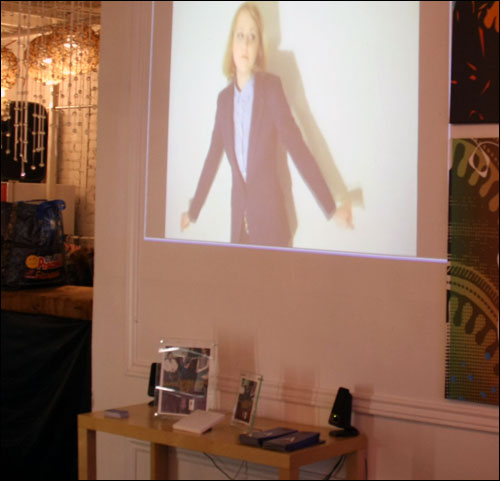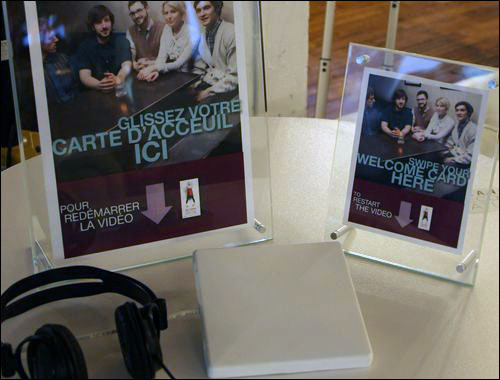The Apollo Agency, a Montreal marketing and communications firm specializing in product launches, personalized messaging campaigns and event coordination, has begun incorporating RFID technology into the functions that it runs. At a networking event last month, featuring local band St. Ange, and held at Montreal’s trendy Loft Le 4ème, the band’s lead singer, Angela Galuppo, greeted every guest, many by name. The greetings were not delivered in person, however—they were conveyed through the use of video and radio frequency identification technologies. Each visitor was provided with a “welcome” card containing an EPC Gen 2 passive ultrahigh-frequency (UHF) tag that could be used to not only receive the greeting, but also trigger St. Ange music videos. The RFID solution was provided by research, development, consulting and training center Academia RFID.
The system, says Eric Sicotte, the Apollo Agency’s CEO, added excitement to the party, by providing technology that few attendees had seen before. He plans to incorporate RFID into the agency’s next party—scheduled for Jan. 19, 2012—which will feature Canadian popular celebrity hunter Marc Andrew. Once again, arriving guests will be greeted individually, this time by Andrew.

The Apollo Agency hosts parties at Loft Le 4ème for corporate events, as well as for “Apollo Thursday,” a monthly theme party that often includes members of the media, celebrities, company executives and event planners. The theme for November’s party was music, featuring St. Ange and the release of the group’s debut album.
“We’re always looking out for new ways to enhance our events, to further personalize them,” Sicotte says. Typically, corporate functions and parties tend to be fairly conservative, he explains, providing the same types of food, beverages, disc jockeys or live music. As such, the Apollo Agency continually seeks innovative ways to spice things up. “We knew about RFID technology, and were interested in how we could use it,” he states. So the company met with Academia RFID’s test team to develop an interactive RFID system, and the team began working with the marketing firm on an RFID-enabled system approximately two months prior to the November event.
The system designed includes Impinj Speedway Revolution R420 readers, installed at two locations: at the entrance to the loft, and within the party area itself. Each reader was wired to a Motorola Solutions AN710 RFID antenna. The group issued 400 to 500 welcome cards, each printed with a particular guest’s name and category—such as of the type of work he or she did, as well as the languages spoken by that person. In addition, each card contained a UPM RFID Short Dipole RFID tag that Academia RFID encoded with a unique ID number. That ID was linked to that individual’s name and other details, by middleware provided by Effecto Solutions. This information was then stored in the Apollo Agency’s software, where it was linked to a greeting that would be played each time that person arrived.
Prior to the event, each guest registered online, and then printed his or her own ticket, which included a bar-coded number. As a visitor arrived at Loft Le 4ème on Thursday evening, the bar code was scanned, accessing that individual’s registration information, and the guest was provided with an RFID card and a unique ID number linked to his or her details in the company’s back-end system.
Guests then climbed the stairs to the 4th floor, where each was met with a looping video of Galuppo dancing, pacing and standing around, as though waiting for someone to arrive. A reader positioned next to the video image had a sign attached to it, inviting visitors to place their tag near the device. As each new arrival did so, the tag’s ID number was forwarded to the Apollo Agency’s back-end software via a cabled connection, using Effecto middleware to interpret that ID, and was linked to the individual’s category and name. The video loop then changed to display a personalized message recorded by Galuppo. If the guest was one of the first 100 registrants, Galuppo would greet that person by name, saying something along the lines of, “Nice to see you, Heather.” If that person were also a member of the press, she might add, “Don’t forget to pick up a media kit.”
Galuppo prerecorded each personalized greeting prior to the event, with every greeting linked to a particular welcome card’s unique ID number. The categories also included English or French, so that every guest could be greeted in his or her own language. Many attendees, however, did not register until one or two days prior to the party. Those who registered within 48 hours of the function were greeted by one of a series of generic messages prerecorded by Galuppo, so that even late registrants would receive a message upon arrival.

Once inside the party area, guests could utilize their RFID cards to prompt the playing of St. Ange’s latest music video. An Impinj reader was installed at one side of the room, next to a sign indicating that guests should swipe their welcome cards across the Motorola antenna. Each time a person did so, the video began playing on a screen beside the interrogator, and attendees could don headphones in order listen to it.
The system worked well, Sicotte says, though the Apollo Agency learned that the welcome video screen and reader were positioned too closely to the party area, where the music being played made it difficult for guests to hear Galuppo’s greetings. In the future, the marketing firm plans to install the video projector and reader on the ground floor, so that guests will be greeted before going upstairs.
In addition to making plans to use the system at the January party, Sicotte says he expects to incorporate RFID in a variety of ways at other functions as well. “I think new technology has to be tamed,” he states, “used and tried until we find the best uses. Once we’ve got the best uses nailed down, we will be using this for all our client events.”


